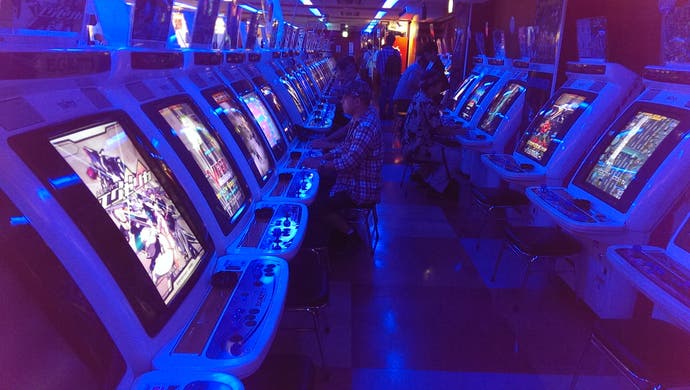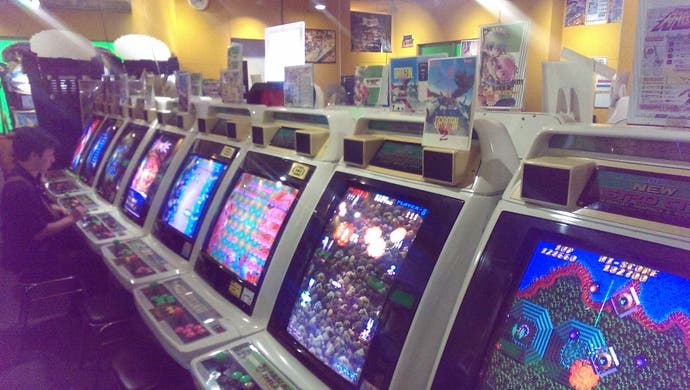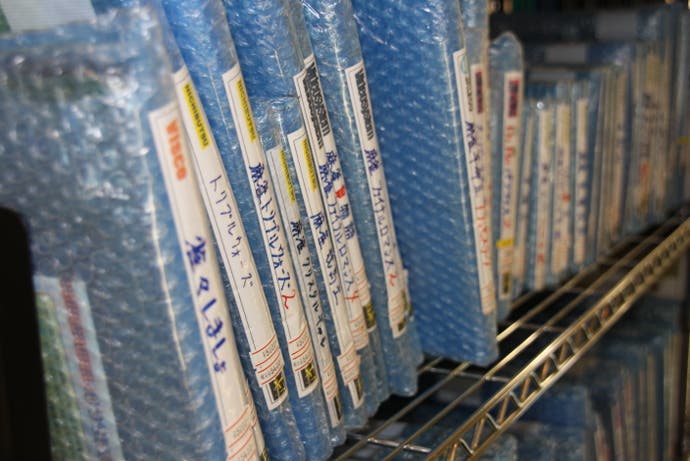Arcade hunting in Akiba
Shopping for boards in Japan's geek capital.
It's everything you'd hope for. There's a dream-like projection of the Japanese arcade, where candy cabinets sit stretched out row upon row in smoky, dark rooms, sugar rush soundtracks and freshly sunk 100 yen coins chiming together to create a chirpy wall of static. In the game stations of Shinjuku and Shibuya, it's a scene that's harder to come by, tastes having moved on to the likes of Gundam Versus EX, Lords of Vermillion - a card-battling series in its third instalment that looks like a hyperactive Hearthstone - or more recent entrants like Square Enix's Gunslinger Stratos, an athletic light gun shooter with a gloriously extreme cabinet. They're excellent games, and wonderful places, but you'd be forgiven for wanting to look elsewhere to get closer to that well-worn ideal.
There used to be more traditional arcades in the heart of Tokyo, though they seem to be diminishing in number - a once worn-down arcade where the cabinets were 50 yen a play closed over a year ago, an empty facade all that's left of a former favourite - but in Akihabara they're still rich in number, and rich in cabinets stocked with countless classic games. If you're lucky enough to find yourself over there, I'd recommend two destinations - the HEY centre on the main strip, and the Try Tower that sits about five minutes walk away from Akihabara's station.

The number of games on display is staggering, the sensory smack of seeing so many of them lined up and switched on in unison overwhelming. Both wind up through floor after floor of cabinets: shooters sit on one, fighting games on another and mixed in are all sorts of esoterica. Taito has a stake in HEY, which makes for some neat curation: at the centre of the shooter floor G Darius, Darius EX and Metal Black all sit together, while on the fringes there's the three-monitor original sitting alongside the more recent widescreen presentation of Dariusburst.
In Try you can see the Gradius family happily clumped together, Salamander and its sequel joining all four mainline arcade games and the original Parodius thrown in for good measure, and there are far more offbeat selections to pick through too. Image Fight, the Irem shooter that provided the template for Treasure and Hiroshi Iuchi's Radiant Silvergun (which is there, of course, alongside its successor Ikaruga), is one of the more popular cabinets, older players with salt and pepper hair exhibiting high level skills that haven't been lost over the years.

That's what's great about the arcades of Akihabara; they're museums where the exhibits are there to be played with, snapshots of a time where whisps of tobacco smoke serve as a sepia filter. They're recreations of an image that's become embedded with players of a certain generation, like myself, raised on ports and hand-me-downs on the Mega Drive of their bigger, more elusive arcade brethren. It was a time when arcade perfection was the highest achievement of so many games, and that's what these places are: arcades perfected, seemingly limitless lines of games that once were playground myths.
Like a fair few of that generation I've been attempting to bottle some of that mystique for myself at home, having picked up an arcade cabinet a few years ago. It's still one of my favourite acquisitions, a Sega New Astro City machine complete with those soft, curving lines, that glowing green marquee and the joyous promise of high definition sounds and visuals slapped haphazardly on the side.

A trip to Akihabara is the perfect opportunity to stock up on new arcade boards, and the area is home to some of the finest shops dealing in this particular speciality that I know of. G-Front's the most prominent, sat above a cafe on the further reaches of Akihabara, an imposing and not particularly user-friendly place. The goods are mostly hidden out of sight, with just a handful of boards and marquees out front and your best bet for picking something up being checking out the stock list that's helpfully posted online.
Mak Japan's a better place for window shopping, even if those windows are all placed precariously close together across cramped floor space some six stories up in a building on the main stretch. Boards are meticulously wrapped, labelled and indexed, lines of Konami games clumped together and running into shelves building with Namco's Type 246 hardware. It makes for a delicious library, antiques and curios all delicately handled and meticulously catalogued. Mak's staff are a friendly bunch, too - despite my complete inability to speak any Japanese I was happily guided to a Garou: Mark of the Wolves MVS, this year's acquisition that came at a fraction of the price it'd cost to pick up in the UK.

Some places aren't quite so user-friendly, though that only really adds to their charm. Try has its own store, somewhat confusingly separate from the arcade tower, and somewhat obtusely sitting on an unmarked floor deep in the sprawl of central Akihabara. A couple of years back I dragged Eurogamer's Wesley Yin-Poole around in search of it - a task he probably wasn't really up for, having only gone to sleep a couple of hours beforehand and having woken up with his shorts having been stolen - and it was a long, sweaty struggle. The end reward was worth it, though - a Gradius 2 board that's become my pride and joy.
People often ask why bother going to such measures, and why not just install MAME in my cabinet at home. There's magic in the hardware itself, something lost entirely in emulation. Having only a handful of games at any one time inspires a more intimate relationship with them, too - when presented with a 1000 games, it's all too easily to tear through so many for a minute at a time before impatiently moving on. Perhaps more importantly, though, it's about the hunt, and the annual thrill of working through Akihabara's many, many treasures.

